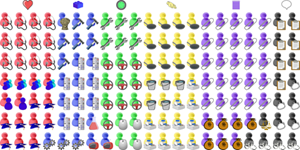Elementary Particles
| leptons |
| quarks |
| fundmental bosons |
| νe |
| νμ |
| ντ |
| νe |
| νμ |
| ντ |
| e− |
| μ |
| τ |
| e+ |
| μ |
| τ |
| u |
| c |
| t |
| u |
| c |
| t |
| d |
| s |
| b |
| d |
| s |
| b |
| H0 |
| γ |
| W− |
| W+ |
| Z |
| g |
| G |
| mass |
| spin |
| charge |
| electronic number |
| muonic number |
| tauonic number |
| baryon number |
| isospin |
| charm |
| strangeness |
| topness |
| bottomness |
| particles |
| antiparticles |
| fermions |
| bosons |
Notes
This representation of 31 elementary particles shows what things are really made of
These 31 elementary particles are the most fundamental constituents of the universe. They are not, as far as we know, made up of other particles. The proton, for example, is not an elementary particle, because it is made up of three quarks, whereas the electron is an elementary particle, because it seems to have no internal structure.
31 seems a lot of elementary particles, but most of what we think of as matter consists of just 3 of them: the up quark, the down quark and the electron (protons and neutrons are both made of up and down quarks; atoms are made of protons, neutrons and electrons; most of what we think of as matter is made of atoms). We should remember, however, that much of the mass of atoms is due to the gluons that bind the quarks; nor should we forget about the photons that bind the electrons to the quarks.
2 of the elementary particles are speculative. No-one has ever observed a Higgs boson or a graviton. They have both been dreamt up by physicists in an attempt to explain mass and the gravitational force.
Where do these 31 elementary particles come from? Why 31? Why these 31, rather than some other 31? Nobody knows.
Every inch of this visualization is active. Move your mouse over a particle to show its name, classification, properties and further information. Move your mouse over a category to show which particles belong to that category. Or move your mouse over a property to show the value of that property for each of the particles. Click on a control to hold it down, then click elsewhere to release it.
Subscribe now and I’ll let you know whenever I create a new visualization
It’ll only be every couple of months or so, I won’t let anyone else have your email address, and you can unsubscribe at any time
Thanks for subscribing!
Check your inbox for an email to confirm your subscription
Oh no, something went wrong, and I was unable to subscribe you!
Please refresh your browser and try again
More
This is one of a series of visualizations of what things are made of, from elementary particles to organic molecules…
Elementary Particles – this page
…check back soon for the next in the series
Latest things made thinkable
Text
A text summary of this presentation is shown below for easy reference
Particles
electron neutrino νe
muon neutrino νμ
tau neutrino ντ
electron antineutrino νe
muon antineutrino νμ
tau antineutrino ντ
electron e−
electrons are among the most common particles in our world, giving atoms their chemical properties
muon μ
tau τ
positron e+
positrons are antielectrons
antimuon μ
antitau τ
up quark u
up quarks and down quarks are the constituents of neutrons and protons, which make up most of the mass in atoms; this means that most of the matter in our world consists of up quarks, down quarks and the gluons that bind them
charm quark c
top quark t
up antiquark u
charm antiquark c
top antiquark t
down quark d
up quarks and down quarks are the constituents of neutrons and protons, which make up most of the mass in atoms; this means that most of the matter in our world consists of up quarks, down quarks and the gluons that bind them
strange quark s
bottom quark b
down antiquark d
strange antiquark s
bottom antiquark b
Higgs boson H0
Higgs bosons had never been observed prior to 14 March 2013, when evidence for one was found in data from the Large Hadron Collider; physicists hypothesize that Higgs bosons are responsible for the masses of other particles
photon γ
photons are particles of light (not just infra-red, ultra-violet and visible light, but radio waves, microwaves, x-rays and gamma rays too); photons mediate the electromagnetic force, which holds electrons in atoms
W boson W−
W and Z bosons mediate the weak nuclear force, which is involved in radioactive decay
anti-W boson W+
W and Z bosons mediate the weak nuclear force, which is involved in radioactive decay
Z boson Z
W and Z bosons mediate the weak nuclear force, which is involved in radioactive decay
gluon g
gluons mediate the strong nuclear force, which holds quarks in protons and neutrons, and holds protons and neutrons in atomic nuclei
graviton G
gravitons have never been observed, but physicists hypothesize that they mediate the gravitational force, which holds planets in orbit around stars
Categories
particles
almost all the matter in our world consists of particles rather than antiparticles; atoms, for example, consist of up quarks, down quarks and electrons rather than up antiquarks, down antiquarks and positrons
antiparticles
antiparticles are the same as particles, except that they seem to be going backwards through time; every particle has an antiparticle with the same mass and spin but otherwise opposite properties; the exceptions are the photon, Z boson, gluon, Higgs boson and graviton, each of which is its own antiparticle
fermions
fermions are particles with half-integer spin, i.e. spin 1/2, 3/2, etc.; fermions are subject to the exclusion principle, which means that there is a limit to the number of fermions you can squeeze into a small space; because electrons are fermions, this gives rise to all the peculiar chemical properties of atoms
bosons
bosons are particles with integer spin, i.e. spin 0, 1, 2, etc.; bosons are not subject to the exclusion principle, which means that there is no limit to the number of bosons you can squeeze into a small space; this allows gauge bosons to mediate the fundamental forces of nature
elementary particles
elementary particles are the most fundamental constituents of the universe; they are not, as far as we know, made up of other particles; the proton, for example, is not an elementary particle, because it is made up of three quarks, whereas the electron is an elementary particle, because it appears to have no internal structure
leptons
leptons are particles that do not interact strongly with other particles; electrons (along with two heavier but otherwise identical particles called the muon and the tau) are charged, so interact electromagnetically, while neutrinos are uncharged, so interact only weakly (they pass right through the Earth)
quarks
quarks are particles that interact strongly with each other; they have never been observed alone, always bound in twos and threes to form composite particles called hadrons, such as the protons and neutrons from which atomic nuclei are made
fundmental bosons
fundamental bosons mediate the forces of nature: photons (which mediate the electromagnetic force), W and Z bosons (the weak nuclear force), and gluons (the strong nuclear force) are spin-1 vector bosons (also known as gauge bosons); Higgs bosons, first observed on 14 March 2013, are spin-0 scalar bosons, thought to be responsible for the masses of other particles; gravitons, spin-2 bosons hypothesized to explain the gravitational force, have never been observed
Date
First published 23 February 2011











Comments
Click here to leave a comment
Thanks for your comment!
I’ll check it and put it live as soon as I can
Oh no, something went wrong, and I was unable to post your comment!
Please refresh your browser and try again
Bernhardt B. Husen ⋅ 19 April 2013
You write: "This representation of 31 elementary particles shows what things are really made of" ...emphasizing "really".... you forget to emphasize that this is what you REALLY believe !! Because it is not sure at all that the standard model is "watertight"... I guess this comment is very "impolite or inappropriate" in your optic...
Mark Jeffery ⋅ 19 April 2013
That's neither impolite nor inappropriate, it's a great point, Bernhardt. You're right, the Standard Model is, well, just a model; and even if we could be certain that its predictions were correct, would we really then know what things are made of, or would we have no more than a bunch of equations? That's where physics meets philosophy…
James Robert Johnson ⋅ 14 May 2013
I do appreciate this page. It condenses a difficult subject down to where I can almost begin to understand it. Thank you.
Jim H ⋅ 13 April 2015
Thank you
Jonh Doe ⋅ 3 May 2015
Very cool site, but errors like the bottomness and strangeness being wrong (for quarks, flavour sign = charge sign) make me think twice before using it. A bibliographic reference would be useful.
Mark Jeffery ⋅ 18 June 2015
Yes, you're right, Jonh Doe. According to the Wikipedia article on the Gell-Mann–Nishijima formula: "By convention, the flavor quantum numbers (strangeness, charm, bottomness, and topness) carry the same sign as the electric charge of the particle." It's only a convention, but it's one I should follow! Now fixed. Thanks!
Alfred E Lukasek ⋅ 23 February 2016
AWESOME page
Hermann Scheuber, CH-4153 Reinach ⋅ 10 July 2016
Where is the QCD? Why Wikipedia claims 61 particles? I mean there should be 36 quarks. Why I can see only a lot of particles(a new zoo!) but never a real picture, a true model, a fundamental system - a Gell-Mann following picture!
I did a stereo picture, but Wikipedia didn't accept it. I would be glad if you could me tell why!